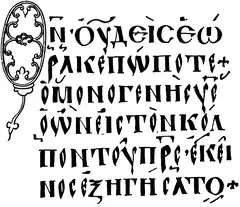Lectionary 150
Lectionary 150, designated by siglum ℓ 150 (in the Gregory-Aland numbering), is also known as Codex Harleianus. It is a Greek manuscript of the New Testament, on vellum leaves and one of four extant Greek lectionaries with explicit dates from before 1000.[1]
| New Testament manuscript | |
 John 1:18 in Codex Harleianus | |
| Name | Harley MS 5598 |
|---|---|
| Text | Gospels |
| Date | 995 |
| Script | Church Slavonic |
| Found | John Covel in 1677 at Constantinople |
| Now at | British Library |
| Size | 35.2 by 26.7 cm |
| Hand | beautifully written |
Description
The manuscript is written in compressed Greek Uncial letters, on 374 parchment leaves (35.2 cm by 26.7 cm), in 2 columns per page, 21 lines per page, with ornaments.[1] The capital letters and nomina sacra are in red ink. The codex includes ten leaves of paper containing a series of Lessons from the Gospels, John, Matthew and the Luke lectionary (Evangelistarium). The image shows the text of John 1:18.
It is one of the most beautiful lectionary codices, with a scribal date of 27 May 995 A.D. 'It is a most splendid specimen of the uncial class of Evangelistaria, and its text presents many instructive variations.'[2] It also contains musical notation.
History
_f_376v_colophon_-_written_by_presbyter_Constantine%252C_dated_27_May_995.jpg.webp)
According to the colophon it was written by a presbyter called Constantine.[3] The manuscript came from Constantinople. In 1677 John Covel, chaplain of the English embassy in Constantinople, purchased this manuscript. It was shown by him to John Mill (1645-1707),[4] in London.[2] From Covel it was purchased – together with other manuscripts – by Robert Harley, Earl of Oxford.[2]
It was collated by Bloomfield and examined by Woide.[3]
The manuscript is often cited in the critical editions of the Greek New Testament (UBS3).[5] It is not cited in UBS4.[6]
The codex is now located in the British Library (Harley MS 5598).[1]
See also
Notes and references
- Aland, Kurt; M. Welte; B. Köster; K. Junack (1994). Kurzgefasste Liste der griechischen Handschriften des Neues Testaments. Berlin, New York: Walter de Gruyter. p. 227. ISBN 3-11-011986-2.
- Scrivener, Frederick Henry Ambrose; Edward Miller (1894). A Plain Introduction to the Criticism of the New Testament. Vol. 1 (4th ed.). London: George Bell & Sons. pp. 336–337.
- Gregory, Caspar René (1900). Textkritik des Neuen Testaments. Vol. 1. Leipzig. p. 466.
{{cite book}}: CS1 maint: location missing publisher (link) - J. Mill, Novum Testamentum, Prolegomena § 1426.
- The Greek New Testament, ed. K. Aland, A. Black, C. M. Martini, B. M. Metzger, and A. Wikgren, in cooperation with INTF, United Bible Societies, 3rd edition, (Stuttgart 1983), p. XXVIII.
- The Greek New Testament, ed. B. Aland, K. Aland, J. Karavidopoulos, C. M. Martini, and B. M. Metzger, in cooperation with INTF, United Bible Societies, 4th revised edition, (United Bible Societies, Stuttgart 2001), p. 21, ISBN 978-3-438-05110-3.
Bibliography
- F. H. A. Scrivener, An Exact Transcript of the Codex Augiensis, to which is added a full Collation of Fifty Manuscripts, London 1859, pp. 47–50.
- Henri Omont, Notes sur les manuscrits grecs du British Museum, Bibliothèque de l’École des Chartes, 45 (1884), p. 337.
- Edward Maunde Thompson, An introduction to Greek and Latin palaeography, Clarendon Press: Oxford 1912, p. 216.
External links
- Harley MS 5598 at the British Library
- "Liste Handschriften". Münster: INTF. Retrieved 7 April 2011.